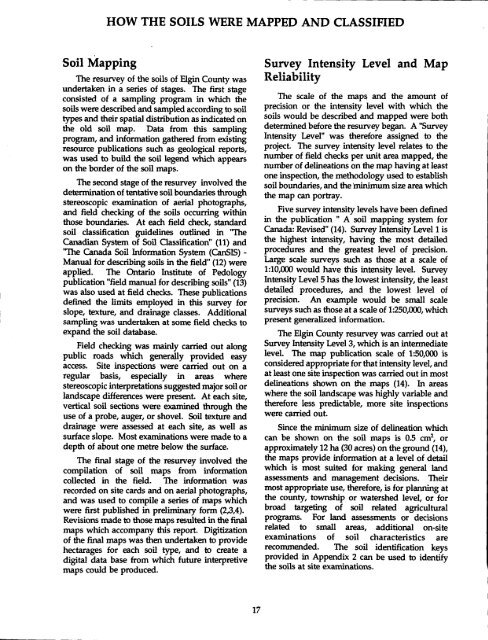The Soils of Elgin County - Agriculture and Agri-Food Canada
The Soils of Elgin County - Agriculture and Agri-Food Canada
The Soils of Elgin County - Agriculture and Agri-Food Canada
- No tags were found...
You also want an ePaper? Increase the reach of your titles
YUMPU automatically turns print PDFs into web optimized ePapers that Google loves.
HOW THE SOILS WERE MAPPED AND CLASSIFIEDSoil Mapping<strong>The</strong> resurvey <strong>of</strong> the soils <strong>of</strong> <strong>Elgin</strong> <strong>County</strong> wasundertaken in a series <strong>of</strong> stages . <strong>The</strong> first stageconsisted <strong>of</strong> a sampling program in which thesoils were described <strong>and</strong> sampled according to soiltypes <strong>and</strong> their spatial distribution as indicated onthe old soil map. Data from this samplingprogram, <strong>and</strong> information gathered from existingresource publications such as geological reports,was used to build the soil legend which appearson the border <strong>of</strong> the soil maps .<strong>The</strong> second stage <strong>of</strong> the resurvey involved thedetermination <strong>of</strong> tentative soil boundaries throughstereoscopic examination <strong>of</strong> aerial photographs,<strong>and</strong> field checking <strong>of</strong> the soils occurring withinthose boundaries. At each field check, st<strong>and</strong>ardsoil classification guidelines outlined in '"<strong>The</strong>Canadian System <strong>of</strong> Soil Classification" (11) <strong>and</strong>"<strong>The</strong> <strong>Canada</strong> Soil Information System (CanSIS) -Manual for describing soils in the field" (12) wereapplied . <strong>The</strong> Ontario Institute <strong>of</strong> Pedologypublication "field manual for describing soils" (13)was also used at field checks . <strong>The</strong>se publicationsdefined the limits employed in this survey forslope, texture, <strong>and</strong> drainage classes . Additionalsampling was undertaken at some field checks toexp<strong>and</strong> the soil database.Field checking was mainly carried out alongpublic roads which generally provided easyaccess. Site inspections were carried out on aregular basis, especially in areas wherestereoscopic interpretations suggested major soil orl<strong>and</strong>scape differences were present. At each site,vertical soil sections were examined through theuse <strong>of</strong> a probe, auger, or shovel. Soil texture <strong>and</strong>drainage were assessed at each site, as well assurface slope . Most examinations were made to adepth <strong>of</strong> about one metre below the surface.<strong>The</strong> final stage <strong>of</strong> the resurvey involved thecompilation <strong>of</strong> soil maps from informationcollected in the field. <strong>The</strong> information wasrecorded on site cards <strong>and</strong> on aerial photographs,<strong>and</strong> was used to compile a series <strong>of</strong> maps whichwere first published in preliminary form (2,3,4).Revisions made to those maps resulted in the finalmaps which accompany this report. Digitization<strong>of</strong> the final maps was then undertaken to providehectarages for each soil type, <strong>and</strong> to create adigital data base from which future interpretivemaps could be produced .Survey Intensity Level <strong>and</strong> MapReliability<strong>The</strong> scale <strong>of</strong> the maps <strong>and</strong> the amount <strong>of</strong>precision or the intensity level with which thesoils would be described <strong>and</strong> mapped were bothdetermined before the resurvey began. A"SurveyIntensity Level" was therefore assigned to theproject. <strong>The</strong> survey intensity level relates to thenumber <strong>of</strong> field checks per unit area mapped, thenumber <strong>of</strong> delineations on the map having at leastone inspection, the methodology used to establishsoil boundaries, <strong>and</strong> theminimum size area whichthe map can portray.Five survey intensity levels have been definedin the publication " A soil mapping system for<strong>Canada</strong> : Revised" (14). Survey Intensity Level 1 isthe highest intensity, having the most detailedprocedures <strong>and</strong> the greatest level <strong>of</strong> precision.Large scale surveys such as those at a scale <strong>of</strong>1:10,000 would have this intensity level . SurveyIntensity Level 5 has the lowest intensity, the leastdetailed procedures, <strong>and</strong> the lowest level <strong>of</strong>precision. An example would be small scalesurveys such as those at a scale <strong>of</strong> 1:250,000, whichpresent generalized information.<strong>The</strong> <strong>Elgin</strong> <strong>County</strong> resurvey was carried out atSurvey Intensity Level 3, which is an intermediatelevel. <strong>The</strong> map publication scale <strong>of</strong> 1:50,000 isconsidered appropriate for that intensity level, <strong>and</strong>at least one site inspection was carried out in mostdelineations shown on the maps (14) . In areaswhere the soil l<strong>and</strong>scape was highly variable <strong>and</strong>therefore less predictable, more site inspectionswere carried out .Since the minimum size <strong>of</strong> delineation whichcan be shown on the soil maps is 0.5 cm2, orapproximately 12 ha (30 acres) on the ground (14),the maps provide information at a level <strong>of</strong> detailwhich is most suited for making general l<strong>and</strong>assessments <strong>and</strong> management decisions . <strong>The</strong>irmost appropriate use, therefore, is for planning atthe county, township or watershed level, or forbroad targeting <strong>of</strong> soil related agriculturalprograms. For l<strong>and</strong> assessments or decisionsrelated to small areas, additional on-siteexaminations <strong>of</strong> soil characteristics arerecommended. <strong>The</strong> soil identification keysprovided in Appendix 2 can be used to identifythe soils at site examinations .
















